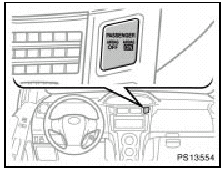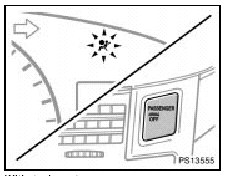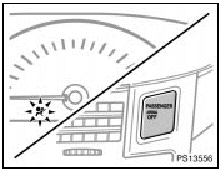 Toyota Yaris: Front passenger occupant classification system
Toyota Yaris: Front passenger occupant classification system
Your vehicle is equipped with a front passenger occupant classification system.
This system detects the conditions.
Based on these conditions, the systems below are activated or deactivated: Front passenger airbag.
Side airbag on the front passenger seat.
Front passenger’s seat belt pretensioner
The system monitors the weight and load on the front passenger seat, and the seat belt buckle switch to determine conditions 1—4.
In order to ensure the system detects the conditions correctly:
Do not place a heavy load on the front passenger seat.
Do not attach a commercial seatback table or other heavy item to the back of the front passenger seat.
Do not apply pressure to the front passenger seat by resting hands or legs on the seatback.

The “AIRBAG ON” and “AIRBAG OFF” indicator lights indicate the actuation of the front passenger airbag, side airbag on the front passenger seat and front passenger’s seat belt pretensioner.
The “AIRBAG ON” and “AIRBAG OFF” indicator lights will be illuminated initially when the ignition key is turned to the “ON” position. After about 4 seconds, they will go off. After that, the front passenger occupant classification system operates and judges which indicator light be illuminated.
The “AIRBAG OFF” indicator light will be illuminated when the ignition switch is in the “ON” position with the condition 2 in the table shown below.
If the front passenger occupant classification system determines that person of adult size sits in the front passenger seat but the “AIRBAG OFF” indicator light is illuminated, one of the following is likely to have occurred: A rear passenger lifts the front passenger seat cushion with their legs.
Objects are placed under the front passenger seat.
The front passenger seatback is in contact with the rear seat.
To ensure the system correctly detects the presence or absence of a person of adult size sitting in the front passenger seat, make sure that none of the above occur.
Make sure that the “AIRBAG ON” indicator light is illuminated when a person of adult size is seated in the front passenger seat.
If the “AIRBAG OFF” indicator light is illuminated, ask the passenger to sit up straight, well back in the seat, and with the seat belt worn correctly. If the “AIRBAG OFF” indicator light remains illuminated, either ask the passenger to move to the rear seat, or if that is not possible, move the front passenger seat fully rearward.

With tachometer

Without tachometer
The SRS warning light and “AIRBAG OFF” indicator light will come on if there is a malfunction in the front passenger occupant classification system.
Contact your Toyota dealer as soon as possible.
Condition and operation in the front passenger classification system

*1: The system judges a person of adult size as an adult. When a smaller adult sits in the front passenger seat, the system may recognize him/her as a child depending on his/her physique and posture.
*2: When a larger child who has outgrown a child restraint system sits in the front passenger seat, the system may recognize him/her as an adult depending on his/her physique or posture.
*3: Never install a rear-facing child restraint system on the front passenger seat. A forward-facing child restraint system should only be installed on the front passenger seat when it is unavoidable. (See “Child restraint” in this Section as for installing the child restraint system.) *4: In the event that the front passenger does not wear a seat belt.
CAUTION.
To avoid potential death or serious injury when the front passenger occupant classification system does not detect the conditions correctly, observe the following.
Do not recline the front passenger seat seatback so that it interferes with a rear seat as it may cause the “AIRBAG OFF” indicator light be illuminated.
If the seatback interferes with the rear seat, return the seatback to a position where it does not interfere with the rear seat.
Keep the front passenger seatback as upright as possible when the vehicle is moving. Reclining the seatback excessively may lessen the effectiveness of the seat belt system.
Make sure the “AIRBAG ON” indicator light is illuminated when using the seat belt extender for the front passenger seat. If the “AIRBAG OFF” indicator light is illuminated, disconnect the extender tongue from the seat belt buckle, then reconnect the seat belt.
Reconnect the seat belt extender after making sure the “AIRBAG ON” indicator light is illuminated. If you use the seat belt extender while the “AIRBAG OFF” indicator light is illuminated, the front passenger airbag and side airbag on the front passenger side may not activate correctly, which could cause death or serious injury in the event of collision.
If an adult sits in the front passenger seat, the “AIRBAG ON” indicator light should be illuminated. If the “AIRBAG OFF” indicator light is illuminated, ask the passenger to sit up straight, well back in the seat, feet on the floor, and with the seat belt worn correctly. If the “AIRBAG OFF” indicator light still remains illuminated, either ask the passenger to move to the rear seat, or if that is not possible, move the front passenger seat fully rearward.
Wear the seat belt properly.
Make sure the front passenger’s seat belt tab has not been left inserted into the buckle before someone sits in the front passenger seat.
Do not place a heavy load on the front passenger seat.
Do not apply pressure to the front passenger seat by resting hands or legs on the seatback.
Do not let a rear passenger lift the front passenger seat with their feet or press on the seatback with their legs.
Do not put objects under the front passenger seat.
Do not attach a commercial seatback table or other heavy item to the back of the front passenger seat.
Child restraint systems installed on the rear seat should not contact the front seatbacks.
When it is unavoidable to install the forward-facing child restraint system on the front passenger seat, install the child restraint system on the front passenger seat in the proper order. (As for the installation order, see “—Installation with seat belt”).
Do not modify or remove the front seats.
Do not kick the front passenger seat or subject it to severe impact.
Otherwise, the SRS warning light may come on to indicate a malfunction of the detection system. In this case, contact your Toyota dealer immediately.
The “AIRBAG ON” indicator light may be illuminated (the front passenger airbag and side airbag on the front passenger seat may deploy) even if observing the above cautions, when a child sits in, or a forward- facing child restraint system is installed on the front passenger seat. Refer to all the cautions in this Section and “Child restraint” in this Section.
 SRS side airbags and curtain shield airbags
SRS side airbags and curtain shield airbags
The SRS (Supplemental Restraint System) side airbags and curtain shield airbags
are designed to provide further protection for the driver, front passenger and rear
outside passengers in addition ...
 Child restraint
Child restraint
—Child restraint precautions
Toyota strongly urges the use of appropriate child restraint systems for children.
The laws of all 50 states in the U.S.A.
and Canada now require the use of a child ...
See also:
Foamed material application areas
The sections shown in the figure below are filled with foamed material to provide
noise insulation.
Refill with foamed materials after repairing these sections and their surrounding
sections.
HI ...
Fit standards
...
Scrapping of your Toyota
The SRS airbag and seat belt pretensioner devices in your Toyota contain explosive
chemicals. If the vehicle is scrapped with the airbags and pretensioners left as
they are, it may cause an accide ...
